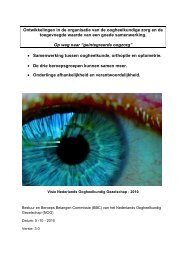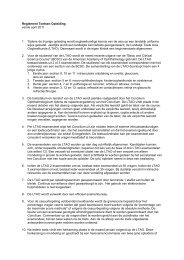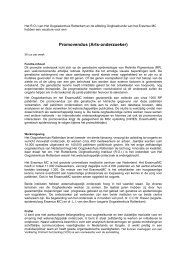terminology and guidelines for glaucoma ii - Kwaliteitskoepel
terminology and guidelines for glaucoma ii - Kwaliteitskoepel
terminology and guidelines for glaucoma ii - Kwaliteitskoepel
Create successful ePaper yourself
Turn your PDF publications into a flip-book with our unique Google optimized e-Paper software.
3.6 - INCISIONAL SURGERY<br />
GENERAL PRINCIPLES<br />
The different techniques of incisional surgeries have different indications depending on the type of <strong>glaucoma</strong>. Angle<br />
closure <strong>glaucoma</strong> is usually treated by laser iridotomy or peripheral iridectomy. Different surgical techniques can be<br />
used depending on:<br />
1. the target IOP chosen <strong>for</strong> the individual situation<br />
2. the previous history (surgery, medications)<br />
3. the risk profile (i.e. single eye)<br />
4. the preferences of the surgeon<br />
Congenital <strong>glaucoma</strong> is suited <strong>for</strong> primary surgery, usually trabeculotomy or goniotomy, or combinations with filtration<br />
surgery including antifibrotic agents.<br />
For repeated surgery, cyclodestructive <strong>and</strong> tube implants are used<br />
See FC XII<br />
TECHNIQUES<br />
Since <strong>glaucoma</strong> surgery is practiced in different ways by different ophthalmologists, a detailed description of surgical<br />
techniques is not within the scope of this text.<br />
For practical treatment of <strong>glaucoma</strong> it is permitted to use additional medications if the target IOP is not reached by<br />
surgery alone. For the scientific evaluation of a surgical method however, success rate in terms of IOP lowering can<br />
only be evaluated in the absence of adjunctive medical treatment. The number of preoperative versus postoperative<br />
medications may also depend on the variable compliance of the individual patient be<strong>for</strong>e <strong>and</strong> after surgery. For<br />
scientific evaluation of a surgical method, it is useful to count the number of “successes” below a defined cut-off line<br />
<strong>for</strong> IOP as in Fig. 3.3 or calculated according to the CIGTS <strong>for</strong>mula 98 or similar methods.<br />
3.6.1 - PENETRATING GLAUCOMA SURGERY<br />
3.6.1.1 - Trabeculectomy<br />
The current operation of choice in POAG is the trabeculectomy, which produces a ‘guarded’ fistula between the<br />
anterior chamber <strong>and</strong> the subconjunctival space 92 . The introduction of improved operating microscopes, instruments<br />
<strong>and</strong> suture materials, has led to numerous modifications <strong>and</strong> refinements of the original operation. Modifications<br />
include the size, shape <strong>and</strong> thickness of the scleral flap, limbal or <strong>for</strong>nix based conjunctival flaps, fixed, releasable or<br />
adjustable sutures <strong>and</strong> the use of antimetabolites <strong>and</strong> other antiscarring agents to reduce scarring. In the h<strong>and</strong> of<br />
experts the success rate of filtering surgery (alone, or with adjunctive medical therapy) in a previously unoperated<br />
eye is reported up to 90% at 2 years; there are large differences however in the criteria used <strong>for</strong> the definition of success<br />
100-109 . Long-term IOP control is achieved in many cases, although some patients do require further therapy or<br />
repeat surgery. Non penetrating <strong>for</strong>ms of filtration surgery are also practiced although the majority of r<strong>and</strong>omised<br />
controlled trials suggest that the pressure lowering is not as great as trabeculectomy.<br />
INDICATIONS<br />
1. In cases where other <strong>for</strong>ms of therapy (namely medicine or laser) have failed.<br />
2. In cases where other <strong>for</strong>ms of therapy are not suitable (eg. where compliance or side-effects are a problem) or<br />
appropriate medical treatment is not available.<br />
3. In cases where a target pressure is required that cannot be reached with drops <strong>and</strong>/or laser.<br />
4. In cases which have such a high IOP at presentation that other <strong>for</strong>ms of treatment are unlikely to be successful 95 .<br />
Ch. 3 - 33 EGS
















